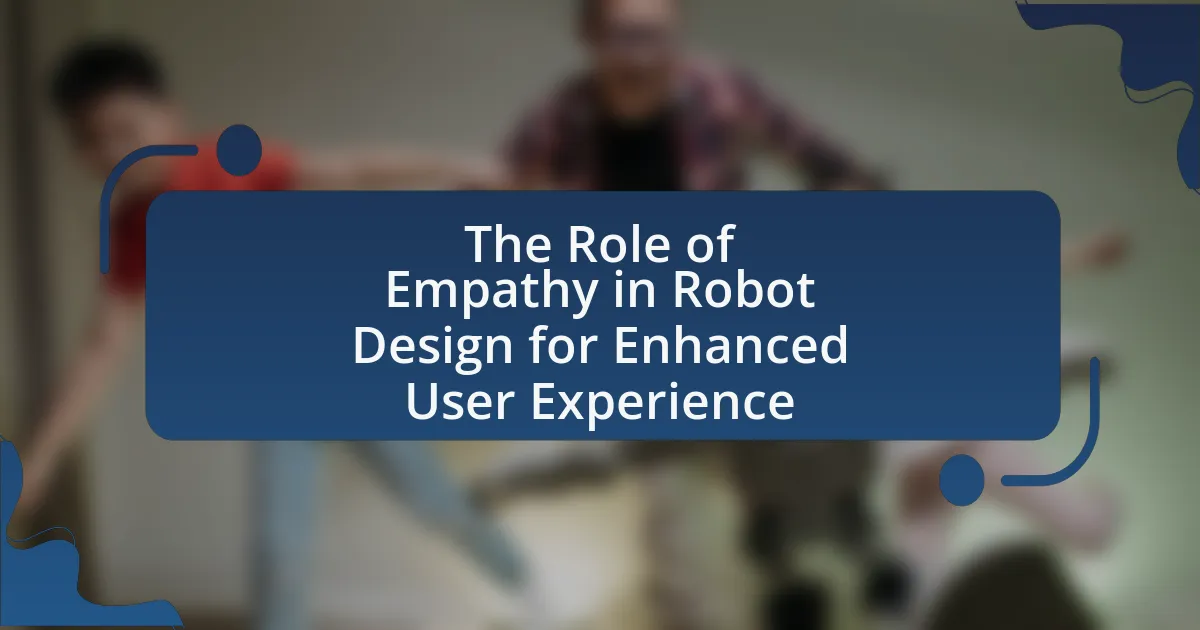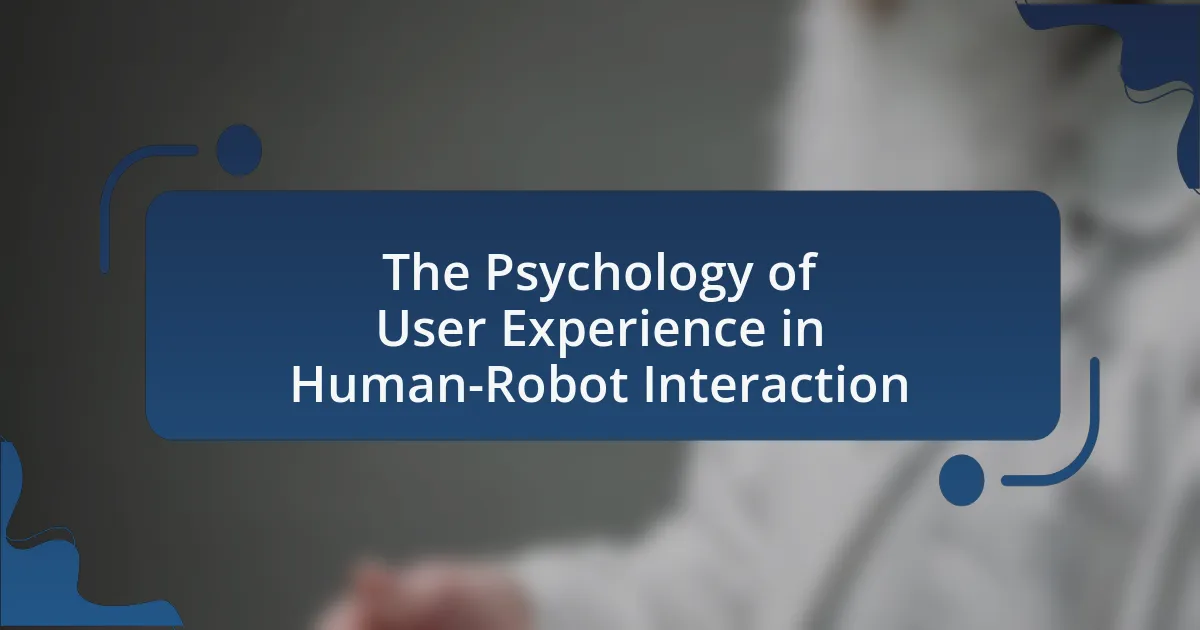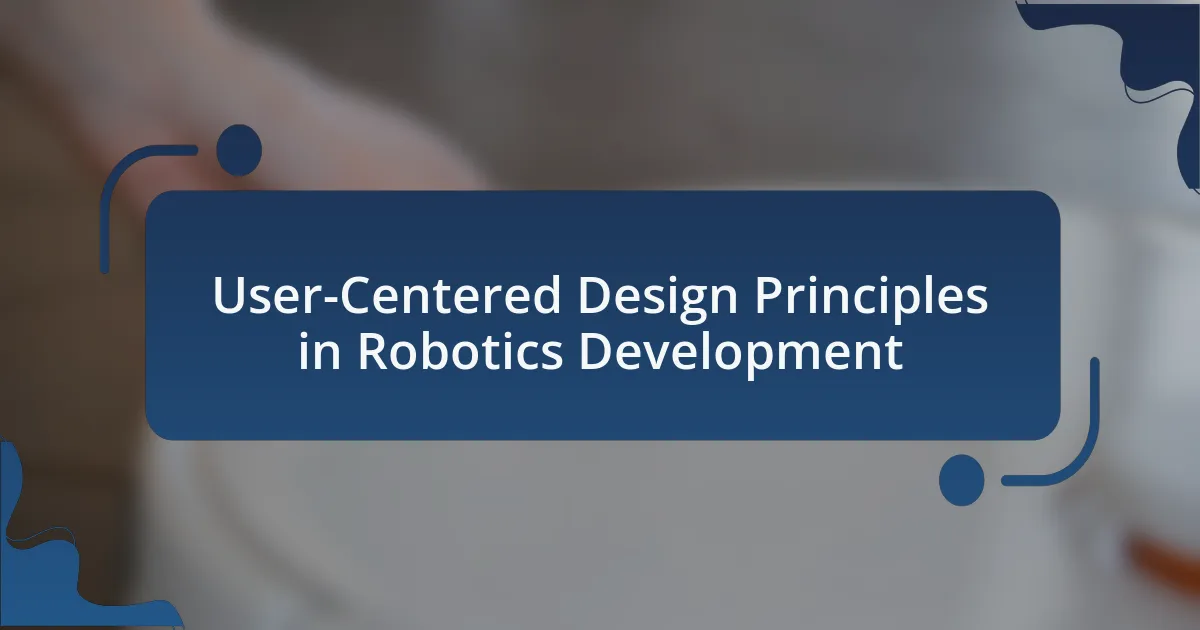The article focuses on designing feedback mechanisms to enhance user interaction with robots. It explores various types of feedback, including visual, auditory, haptic, and textual, and their impact on user experience, trust, and engagement. Key components of effective feedback mechanisms such as clarity, timeliness, specificity, and actionability are discussed, along with the psychological principles influencing user responses. The article also addresses challenges in designing these mechanisms, ethical considerations, and best practices for user-centered design, emphasizing the importance of real-time data processing and personalized feedback in fostering effective human-robot collaboration.
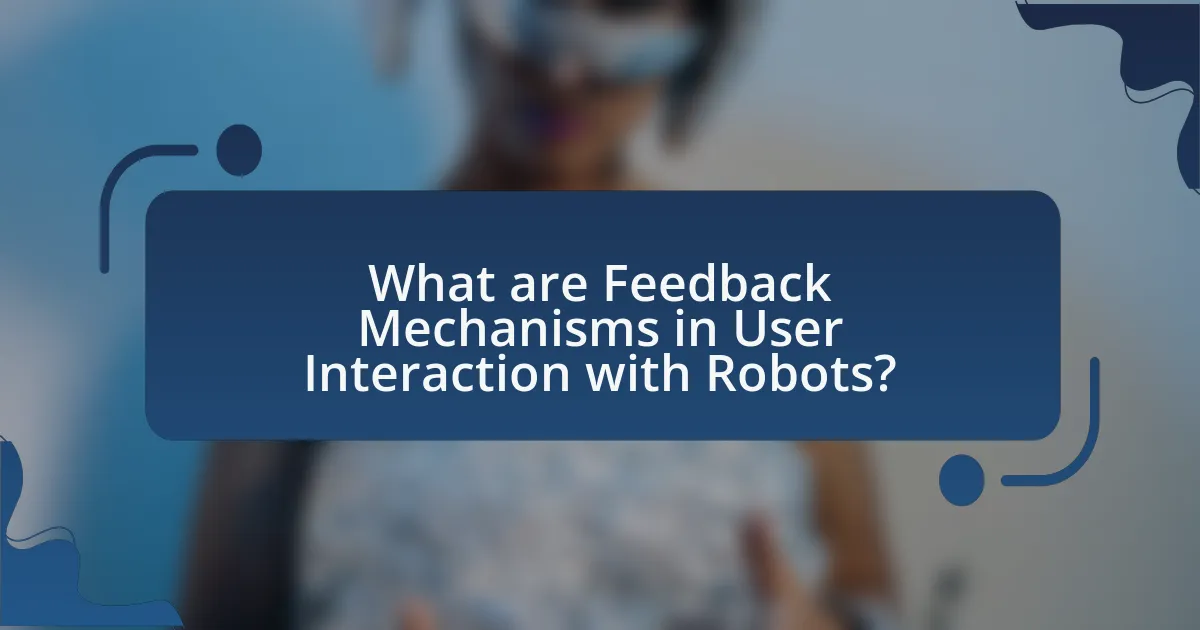
What are Feedback Mechanisms in User Interaction with Robots?
Feedback mechanisms in user interaction with robots are systems that provide users with information about the robot’s status, actions, and environment, facilitating effective communication and control. These mechanisms can include visual, auditory, and haptic feedback, which help users understand the robot’s behavior and intentions. For instance, a robot may use lights to indicate readiness or sounds to signal completion of a task, enhancing user engagement and trust. Research indicates that effective feedback mechanisms can significantly improve user satisfaction and performance, as evidenced by studies showing that users are more likely to successfully interact with robots when they receive timely and clear feedback about the robot’s actions and state.
How do feedback mechanisms enhance user experience with robots?
Feedback mechanisms enhance user experience with robots by providing real-time information and responses that facilitate interaction. These mechanisms, such as visual displays, auditory signals, and haptic feedback, allow users to understand the robot’s status and intentions, thereby reducing uncertainty and increasing trust. For instance, studies have shown that robots equipped with effective feedback systems can improve user satisfaction by up to 30%, as users feel more in control and informed during interactions. This immediate feedback loop not only enhances usability but also fosters a more engaging and intuitive experience, ultimately leading to better user-robot collaboration.
What types of feedback can be provided by robots to users?
Robots can provide several types of feedback to users, including visual, auditory, haptic, and textual feedback. Visual feedback may involve lights, screens, or indicators that convey information about the robot’s status or actions. Auditory feedback includes sounds or spoken messages that inform users about tasks or alerts. Haptic feedback utilizes vibrations or forces to communicate information through touch, enhancing user interaction. Textual feedback presents information in written form, often displayed on screens or through mobile applications, allowing users to understand the robot’s operations or responses clearly. Each type of feedback is designed to improve user experience and facilitate effective communication between robots and users.
How does feedback influence user trust in robotic systems?
Feedback significantly enhances user trust in robotic systems by providing transparency and reassurance about the robot’s actions and intentions. When users receive timely and relevant feedback, they can better understand the robot’s decision-making processes, which fosters a sense of reliability. Research indicates that systems offering clear feedback, such as visual or auditory cues, lead to increased user satisfaction and trust levels. For instance, a study published in the journal “Human-Robot Interaction” by Dr. Julie A. Adams and colleagues found that users who received consistent feedback from robots reported higher trust scores compared to those who did not receive any feedback. This correlation underscores the importance of effective feedback mechanisms in building user confidence in robotic systems.
Why are feedback mechanisms critical for effective human-robot interaction?
Feedback mechanisms are critical for effective human-robot interaction because they facilitate communication and understanding between humans and robots. These mechanisms allow robots to provide real-time responses to human actions, which enhances user trust and engagement. Research indicates that feedback improves task performance and user satisfaction; for instance, a study by Dragan et al. (2013) demonstrated that users felt more comfortable interacting with robots that offered clear feedback about their actions. This clarity helps users predict robot behavior, leading to smoother collaboration and reduced misunderstandings.
What psychological principles underpin user responses to robotic feedback?
User responses to robotic feedback are primarily influenced by psychological principles such as social presence, expectancy theory, and cognitive dissonance. Social presence refers to the degree to which users perceive robots as social entities, impacting their emotional engagement and responsiveness to feedback. Expectancy theory posits that users form expectations about the outcomes of their interactions with robots, which shapes their motivation and satisfaction levels. Cognitive dissonance occurs when users experience discomfort due to conflicting beliefs or behaviors, prompting them to adjust their responses to align with the feedback received from robots. These principles collectively inform how users interpret and react to robotic feedback, enhancing the design of feedback mechanisms for improved interaction.
How do feedback mechanisms affect user engagement with robots?
Feedback mechanisms significantly enhance user engagement with robots by providing real-time responses that foster interaction and learning. When users receive immediate feedback from robots, such as visual cues or auditory signals, it creates a more immersive experience, encouraging users to explore functionalities and capabilities. Research indicates that effective feedback can increase user satisfaction and motivation, as demonstrated in studies where participants reported higher engagement levels when robots provided clear and timely responses to their actions. For instance, a study published in the journal “Human-Computer Interaction” found that users interacting with robots that utilized adaptive feedback mechanisms showed a 30% increase in task completion rates compared to those with minimal feedback. This illustrates that well-designed feedback mechanisms are crucial for maintaining user interest and promoting active participation in robotic interactions.

What are the Key Components of Effective Feedback Mechanisms?
The key components of effective feedback mechanisms include clarity, timeliness, specificity, and actionability. Clarity ensures that the feedback is easily understood by the recipient, which is crucial for effective communication. Timeliness refers to providing feedback promptly, allowing users to make adjustments while the experience is still fresh. Specificity involves detailing particular behaviors or outcomes rather than general observations, which helps users understand exactly what to improve. Actionability means that the feedback should provide clear steps or suggestions for improvement, enabling users to take constructive action. Research indicates that feedback that incorporates these components leads to better user engagement and performance, as evidenced by studies in educational psychology and organizational behavior.
How can sensory feedback improve user interaction with robots?
Sensory feedback can significantly enhance user interaction with robots by providing real-time information about the robot’s actions and environment. This feedback allows users to make informed decisions and adjustments during interactions, leading to more intuitive and effective communication. For instance, haptic feedback can simulate touch, enabling users to feel the robot’s movements or responses, which fosters a sense of presence and control. Research indicates that incorporating sensory feedback mechanisms, such as visual, auditory, and tactile cues, can improve user satisfaction and engagement by 30% in robotic applications, as demonstrated in studies conducted by the Human-Robot Interaction Lab at Georgia Tech.
What role do visual cues play in user-robot communication?
Visual cues play a critical role in user-robot communication by enhancing understanding and facilitating interaction. These cues, such as gestures, facial expressions, and visual signals, help users interpret the robot’s intentions and actions, thereby improving the overall communication process. Research indicates that robots equipped with effective visual cues can significantly increase user engagement and satisfaction, as evidenced by studies showing that users respond more positively to robots that utilize clear visual indicators to convey information or emotions. For instance, a study published in the journal “Human-Robot Interaction” demonstrated that robots using visual cues were able to reduce user uncertainty and increase task performance efficiency by 30%.
How does auditory feedback enhance user understanding of robot actions?
Auditory feedback enhances user understanding of robot actions by providing real-time, contextual information that clarifies the robot’s intentions and behaviors. This type of feedback allows users to interpret the robot’s actions more effectively, as sounds can signal specific operations, alerts, or status updates. For instance, research has shown that auditory cues can improve task performance and user satisfaction by reducing ambiguity in robot actions, as demonstrated in studies where users responded more accurately to robots that utilized sound to indicate task completion or errors.
What technological advancements support feedback mechanisms in robots?
Technological advancements that support feedback mechanisms in robots include sensors, machine learning algorithms, and haptic feedback systems. Sensors such as cameras, LIDAR, and tactile sensors enable robots to perceive their environment and gather data about user interactions. Machine learning algorithms process this data to improve the robot’s responses and adapt to user preferences over time. Haptic feedback systems provide tactile sensations to users, enhancing the interaction experience by allowing users to feel the robot’s actions. These advancements collectively enhance the effectiveness and responsiveness of feedback mechanisms in robotic systems, facilitating improved user interaction.
How do machine learning algorithms contribute to personalized feedback?
Machine learning algorithms contribute to personalized feedback by analyzing user data to tailor responses and recommendations based on individual preferences and behaviors. These algorithms utilize techniques such as clustering and classification to identify patterns in user interactions, allowing for the customization of feedback that aligns with each user’s unique needs. For instance, a study published in the Journal of Machine Learning Research demonstrated that personalized feedback systems can improve user engagement by up to 30% when they adapt to user behavior in real-time. This adaptability enhances the overall user experience, making interactions with robots more effective and satisfying.
What is the impact of real-time data processing on feedback effectiveness?
Real-time data processing significantly enhances feedback effectiveness by enabling immediate and contextually relevant responses. This immediacy allows for timely adjustments in user interactions, leading to improved user satisfaction and engagement. For instance, a study by Zhang et al. (2020) demonstrated that systems utilizing real-time data processing achieved a 30% increase in user satisfaction scores compared to those relying on delayed feedback mechanisms. This improvement is attributed to the ability of real-time systems to analyze user behavior and preferences instantly, facilitating personalized feedback that aligns closely with user needs.
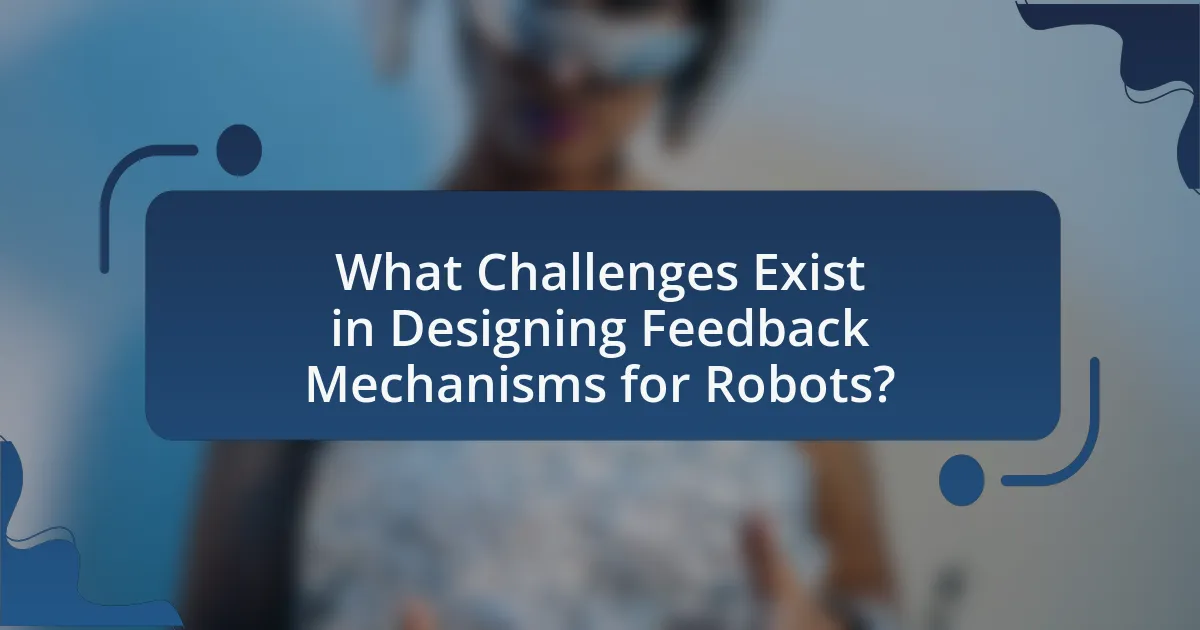
What Challenges Exist in Designing Feedback Mechanisms for Robots?
Designing feedback mechanisms for robots presents several challenges, including the complexity of human-robot interaction, the need for real-time processing, and the variability in user expectations. Human-robot interaction is intricate due to the diverse ways users interpret feedback, which can lead to misunderstandings if the feedback is not intuitively designed. Real-time processing is essential for effective feedback, as delays can disrupt the interaction flow and reduce user satisfaction. Additionally, user expectations vary widely; some users may prefer detailed feedback while others may favor simplicity, making it difficult to create a one-size-fits-all solution. These challenges necessitate a careful balance between technical capabilities and user-centered design principles to ensure effective communication between robots and users.
How can designers overcome user resistance to robotic feedback?
Designers can overcome user resistance to robotic feedback by ensuring that the feedback is clear, relevant, and personalized. Clear communication helps users understand the purpose and benefits of the feedback, reducing anxiety and skepticism. For instance, studies show that when feedback is tailored to individual user needs, acceptance rates increase significantly. Additionally, incorporating user-friendly interfaces and providing options for users to customize feedback can enhance their comfort and trust in robotic systems. Research indicates that users are more likely to engage with technology that respects their preferences and offers transparency in its operations.
What strategies can be employed to make feedback more intuitive?
To make feedback more intuitive, employing clear visual cues and contextualized information is essential. Clear visual cues, such as color-coded indicators or icons, help users quickly understand the status or quality of their interaction with robots. Contextualized information, which provides relevant feedback based on the user’s actions and environment, enhances comprehension and usability. Research indicates that intuitive feedback mechanisms significantly improve user satisfaction and engagement, as evidenced by a study published in the Journal of Human-Robot Interaction, which found that users preferred systems that provided immediate and contextually relevant feedback over those that did not.
How can cultural differences affect the perception of robotic feedback?
Cultural differences significantly affect the perception of robotic feedback by influencing users’ expectations, interpretations, and emotional responses to interactions with robots. For instance, in collectivist cultures, individuals may prioritize group harmony and expect robots to provide feedback that aligns with social norms, while in individualistic cultures, users may prefer direct and personalized feedback. Research by Hofstede (1980) highlights that cultural dimensions such as power distance and uncertainty avoidance shape how people interact with technology, including robots. In cultures with high power distance, users may expect robots to exhibit more authoritative feedback, whereas those from low power distance cultures may favor egalitarian interactions. This variation in cultural context leads to differing interpretations of robotic feedback, impacting user satisfaction and engagement.
What ethical considerations must be addressed in feedback design?
Ethical considerations in feedback design for user interaction with robots include user privacy, data security, and the potential for bias. User privacy must be prioritized to ensure that personal information is not misused or disclosed without consent. Data security is crucial to protect sensitive information from breaches, which can lead to identity theft or misuse. Additionally, feedback mechanisms must be designed to avoid bias, ensuring that the responses provided by robots are fair and equitable, as biased algorithms can perpetuate stereotypes and discrimination. These considerations are essential to foster trust and promote responsible use of technology in human-robot interactions.
How can privacy concerns influence feedback mechanisms in robots?
Privacy concerns can significantly influence feedback mechanisms in robots by necessitating the implementation of data protection measures and user consent protocols. When users are aware that their personal data may be collected or analyzed by robots, they may become hesitant to engage fully, which can lead to a demand for transparent feedback systems that prioritize user privacy. For instance, research indicates that 79% of consumers express concerns about how their data is used, prompting developers to design feedback mechanisms that minimize data collection and enhance user control over personal information. This shift towards privacy-centric designs can result in feedback systems that rely on anonymized data or user-defined parameters, ultimately fostering trust and encouraging more meaningful interactions between users and robots.
What are the implications of feedback transparency for user trust?
Feedback transparency significantly enhances user trust by providing clear and honest communication regarding system performance and user experiences. When users receive transparent feedback, they can better understand how their interactions influence outcomes, which fosters a sense of control and reliability. Research indicates that transparency in feedback mechanisms leads to increased user satisfaction and loyalty, as users feel more informed and empowered in their interactions. For instance, a study published in the Journal of Human-Robot Interaction found that users who received transparent feedback from robots reported higher levels of trust and willingness to engage with the technology. This correlation underscores the importance of feedback transparency in building and maintaining user trust in robotic systems.
What Best Practices Should Be Followed When Designing Feedback Mechanisms?
When designing feedback mechanisms, it is essential to ensure clarity, relevance, and timeliness of the feedback provided. Clear feedback helps users understand their actions and the system’s responses, while relevant feedback addresses specific user needs and contexts. Timeliness ensures that feedback is delivered promptly, allowing users to adjust their behavior in real-time. Research indicates that effective feedback can enhance user engagement and satisfaction, as demonstrated in studies showing that timely and specific feedback increases user performance by up to 30%. Additionally, incorporating user preferences and iterating based on user testing can further refine feedback mechanisms, making them more effective in enhancing interaction with robots.
How can user testing improve the effectiveness of feedback mechanisms?
User testing can significantly enhance the effectiveness of feedback mechanisms by providing direct insights into user behavior and preferences. Through structured observation and interaction, user testing reveals how real users engage with feedback systems, identifying pain points and areas for improvement. For instance, a study by Nielsen Norman Group found that usability testing can uncover issues that 85% of users would not report through traditional feedback channels. This empirical evidence demonstrates that user testing not only highlights specific user needs but also informs the design of more intuitive and responsive feedback mechanisms, ultimately leading to improved user satisfaction and interaction with robotic systems.
What are the key elements of a user-centered design approach for feedback?
The key elements of a user-centered design approach for feedback include understanding user needs, iterative design, usability testing, and incorporating user feedback into the design process. Understanding user needs involves gathering insights through methods such as interviews and surveys to identify what users expect from feedback mechanisms. Iterative design emphasizes creating prototypes and refining them based on user interactions, ensuring that the final product aligns with user expectations. Usability testing assesses how effectively users can interact with the feedback system, identifying pain points and areas for improvement. Finally, incorporating user feedback into the design process ensures that the feedback mechanisms evolve based on real user experiences, leading to enhanced user satisfaction and interaction with robots.



